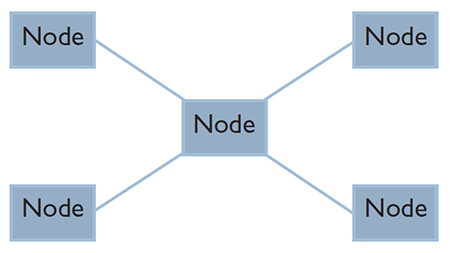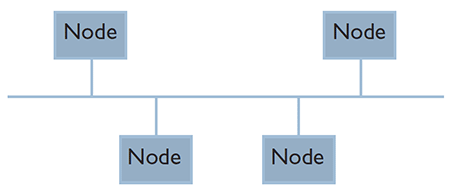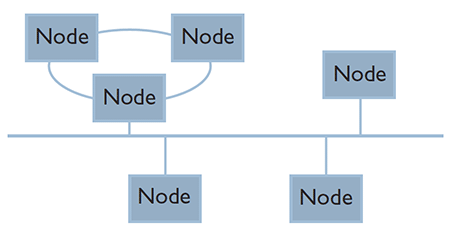Topology
The expression topology refers to how a network is structured; the physical or logical placement of the nodes. There are six basic topologies: point to point, ring, star, bus, combined and mesh network. The choice of topology is important, as it is a long term infrastructure that shall manage and transport important data without downtime.
In addition, it must be possible to adapt and expand the network as and when conditions change.

Topology - point-to-point
Serial point to point
Point to point data communications, i.e. between two communicating devices is one of the most common applications. Both in basic applications, such as computer to printer, and more complex applications, where you choose to allow each user to communicate on their own line for reasons of security. The standard RS-232/V.24 interface is not recommended for transmission distances greater than 15 metres (50 ft). For this reason a modem is used to extend the line and suppress disturbance for communication up to 18 km (11 mi).

Topology - Star Network
Star network
A network with many connected point to point users is known as a star network.
Each device communicates with the central unit in the centre on its own line. The star network offers the advantage of high reliability. When a line goes down the others are not affected. One disadvantage is that more cable is required, resulting in a higher cost, and that all communications must go through the central unit.

Topology - Ring Network
Ring network
A ring network connects all units in series with each other in a closed ring. This means that all communications must pass “through” all devices on the ring in order to be forwarded to the receiver. An “empty slot” is sent round the network to avoid collisions.
The transmitting node checks whether it is empty, attaches its address and adds its data information. The next node in the ring checks whether the contents of the slot are intended for it, if not is passed on. When the receiver receives its slot, he empties its contents and inserts a receipt and sends this out on the network again. The transmitting device checks that the message has been received and acknowledged, it then sends the empty slot forward for new traffic. Token Ring is an example of a ring network from a signal standpoint, which is physically connected as a distributed star network. Ring networks offer high performance, but can be more complicated to build and adapt compared to a bus network.

Topology - Bus Network
Bus network
In principle a bus network consists of a main line where all units are connected as nodes. All data traffic is sent out via the bus to the receiver. A bus network must have regulations for how a transmitting device checks whether the line is free and how it should act in the event of a transmission colliding with other data traffic, for example through delayed retransmission. The bus network is easy to install, expand and extend. Ethernet and AppleTalk are common examples of a bus network. Among the disadvantages is slow traffic when many devices need to communicate on the network. However, the bus network can be divided up into several short buses, which segment the network.

Topology - Combined Network
Combined Network
Using different communication products means that you can create your own customised network solution that combines the advantages of the different topologies, including performance and reliability. For example, a bus network with a distributed star, which is a way to link together several star networks. It is important to remember that each network needs to have a fully working regulation system, traffic regulations, for data communications.

Topology - Mesh Network
Mesh network
Networks that are interconnected without a structure are known as a mesh network.
In a poorly documented network without structure the risk of communication errors created by mistake is considerable. Suppose you connect in another node and in doing so create a loop, a broadcast will then circulate in the network, further broadcasts add traffic and in the end you have a broadcast storm in your network.
Credits: Westermo

